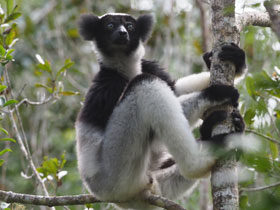The indri or babakoto (Indri indri)
 The indri (Indri indri) is included in the IUCN Red List as "endangered"
The indri (Indri indri) is included in the IUCN Red List as "endangered"
The indri (/ˈɪndri/ ; Indri indri), also called the babakoto is a species of strepsirrhine primate in the family Indriidae, which forms a separate genus Indri. Indri are the largest lemurs alive today and inhabit northeastern Madagascar.
Appearance
Indri indri range in size from 64 to 90 cm and the tail, unlike all other lemurs, is very short, measuring only 4 to 5 cm. The Indri weighs between 6.5 and 9.5 kg. The hind legs are very long, with enlarged thumbs opposite the rest of the toes. The coat is very thick with a white-grey-black pattern, which can vary in appearance. Specimens from the south of the range are lighter in colour and those from the north are darker. The head, ears and back of all Indri are usually black. The ears are large and shaggy, the muzzle almost hairless.
Distribution
The indri, like all lemurs, lives in Madagascar, and its range is in the northeast of the island. Its habitat is tropical rainforests, where it can be found at altitudes of up to 1800 m, preferring, however, lower areas.
Behaviour and song of the indri
The indri lives in trees and only rarely descends to the ground. They move along the branches mainly by means of their strong hind legs, jumping from branch to branch or climbing up and down. On the ground, the Indri moves like all members of the family, hopping on its hind legs and lifting its front legs into the air. Of all lemurs, they are most active during the day and only move around at night in bad weather or when attacked by a predator. They can often be seen perched in a tree on a fork of branches and basking in the sun's rays.
Typical of the Indri is the loud singing in the morning hours, with which they assert their rights to territory. This song, usually between 7 and 11 a.m., is performed by both members of the pair and can be heard from a distance of 2 km.
Nutrition
The indri feeds mainly on leaves; to a lesser extent, it eats fruit and petals. Sometimes they descend to the ground and ingest some soil, which probably helps them to digest poisonous substances in leaves. Like many other plant-eating mammals, the indri compensates for the low nutritional value of its food with long periods of rest.
Reproduction
The indri lives in small groups of two to five individuals, usually consisting of a monogamous pair and their offspring. The female is dominant and has priority in finding food. After the death of a mate, she usually finds a new one. The pair has a strictly demarcated area of 17 to 40 ha, which the male marks with a special secret gland.
Every two to three years, a female gives birth to a calf after a gestation period of five months. It attaches itself to her belly at first and then to her back. After six months, the calf stops drinking its mother's milk and becomes independent at eight months of age, remaining close to its parents for about another year. Females do not reach sexual maturity until they are seven to nine years old.
The average life expectancy of the Indri is not yet clear.
Conservation status
The main threat to the indri today is the destruction of their habitat. They do not allow themselves to be kept under human care, which makes several breeding programmes impossible. In protected areas, they have managed to survive on a small scale, but nevertheless, the IUCN assesses their status as "endangered".
Mythology
Across Madagascar, the indri is revered and protected by fady (taboos). Countless variations are given on the legend of the indri's origins, but they all treat it as a sacred animal, not to be hunted or harmed.
Most legends establish a close relationship between the indri and humans, and many invoke a common ancestry. In some regions, two brothers were believed to have lived together in the forest until one of them decided to leave and cultivate the land. That brother became the first human, and the brother who stayed in the forest became the first indri. The indri cries in mourning for his brother who went astray.
Another legend tells of a man who went hunting in the forest and did not return. His absence worried his son, who went out looking for him. When the son also disappeared, the rest of the villagers ventured into the forest seeking the two, but discovered only two large lemurs sitting in the trees: the first indri. The boy and his father had transformed. In some versions, only the son transforms, and the wailing of the babakoto is analogous to the father's wailing for his lost son.
Another human-like characteristic of the indri is its behavior in the sun. Like its sifaka relatives, the indri frequently engages in what has been described as sun-bathing or sun-worshipping. As the sun rises each morning, it will sit and face it from a tree branch with its legs crossed, back straight, hands low with palms facing out or resting on its knees, and eyes half-closed. Biologists are hesitant to call this behavior sun worship, as the term may be overly anthropomorphic. However, many Malagasy people do believe that the indri worships the sun.
















































